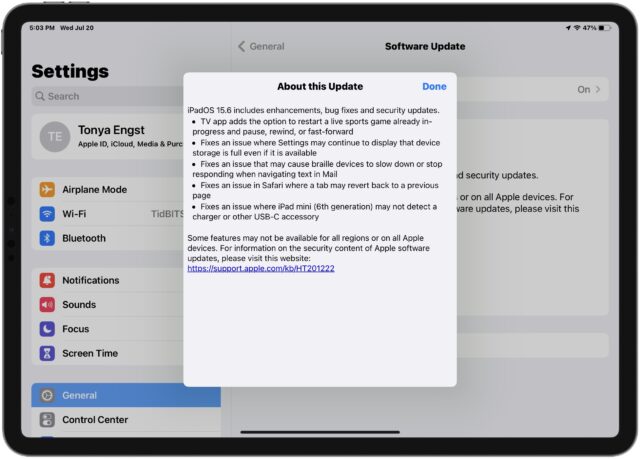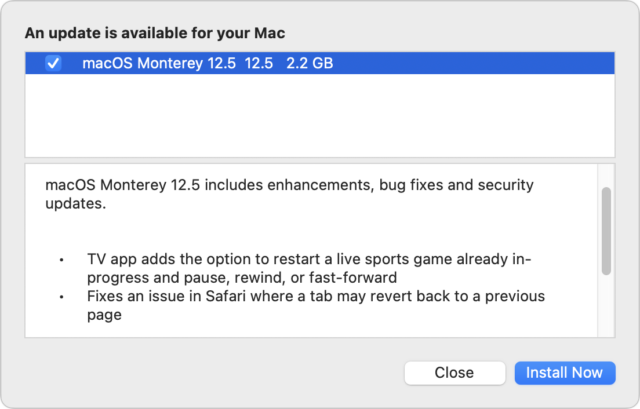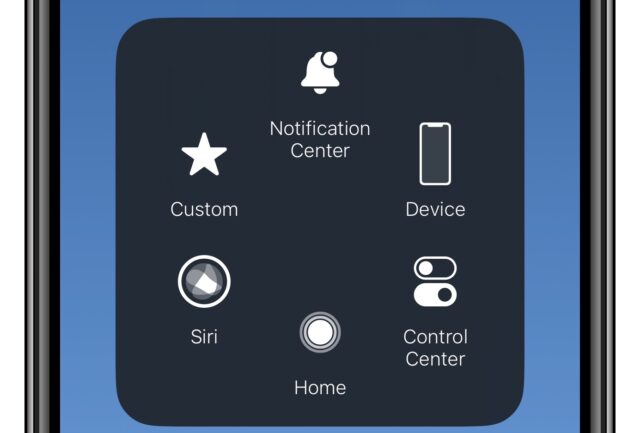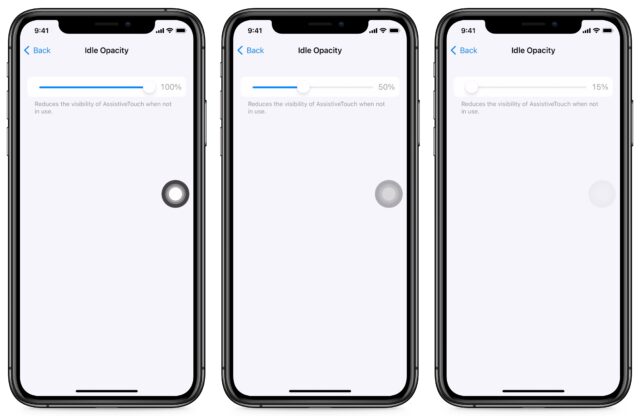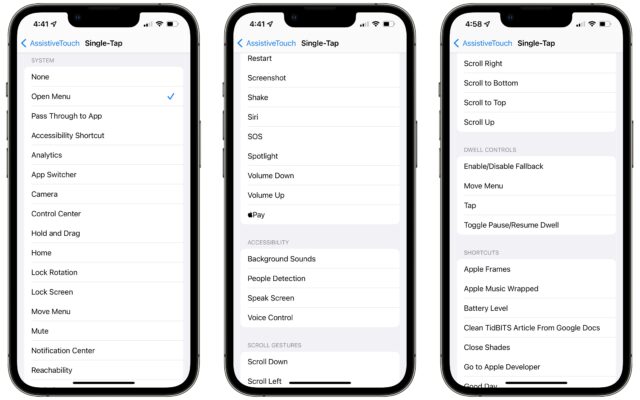#1620: OS updates, AssistiveTouch for iOS shortcut palette, Photos album sharing bug
Last week, Apple released minor updates for its current round of operating systems, along with security updates for macOS 10.15 Catalina and macOS 11 Big Sur. After nearly a decade, Josh Centers revisits the AssistiveTouch feature of iOS and iPadOS to show how—beyond its accessibility uses—you can employ it as a handy palette of custom shortcuts. Finally, Josh points out a bug in Photos that could cause you to share an album with people other than those who you intend. Notable Mac app releases this week include Audio Hijack 4.0.4, macOS Big Sur 11.6.8 and Security Update 2022-005 Catalina, Safari 15.6, Ulysses 27.2, DEVONthink 3.8.5, iFinance 5.0.4, and 1Password 8.8.
iOS 15.6, iPadOS 15.6, macOS 12.5 Monterey, watchOS 8.7, tvOS 15.6, and HomePod Software 15.6
Even though much of Apple’s development work is devoted to polishing the betas of its next-generation operating systems, the company found time to release minor updates for its current operating systems: iOS 15.6, iPadOS 15.6, macOS 12.5 Monterey, watchOS 8.7, tvOS 15.6, and HomePod Software 15.6.
Happily, Apple doesn’t call out any of the security fixes as being actively exploited in the wild, so we recommend waiting a week or so to install these updates to see if they have any side effects. Unless, of course, you’re watching live sports in the TV app.
iOS 15.6 and iPadOS 15.6
In iOS 15.6, the TV app offers more control over live sports broadcasts like pause, rewind, fast-forward, and restart. It also offers a few specific fixes for:
- Safari tabs reverting to the previous page
- A Settings bug that would erroneously show a device’s storage as full
- Braille devices slowing down or not responding when navigating text in Mail
iPadOS 15.6 includes an additional fix for a bug that could prevent the sixth-generation iPad mini from detecting chargers and other USB-C accessories.
iOS 15.6 and iPadOS 15.6 include 37 security fixes.
macOS 12.5 Monterey
Like iOS 15.6, macOS 12.5 Monterey adds additional control options to live sports in the TV app and a fix for the Safari tab issue. It includes 50 security fixes.
watchOS 8.7, tvOS 15.6, HomePod Software 15.6
The remaining updates are even more minimal unless you’re a Chinese or Japanese-speaking HomePod user:
- watchOS 8.7 has unspecified improvements and 26 security fixes.
- tvOS 15.6 has vague update notes and 27 security fixes.
- HomePod Software 15.6 adds Siri voice recognition support for Mandarin, Cantonese, and Japanese. There are no security notes.
Photos Bug Could Share Albums with the Wrong People
Photos for the Mac has a strange bug that could cause you to share an album with people other than those who you intend. Let me show you how to replicate the bug so you can avoid it.
Open Photos and find Shared Albums in the sidebar. Hover the pointer over Shared Albums, and click the + button that appears to open the popover to create a new shared album.
Enter a name for the shared album. Then, click in the Invite People field and start typing a contact’s name. As you type, Photos automatically suggests entries from your contacts. So far, so good.
But let’s say you inadvertently hit the wrong key and press Delete to fix it—perhaps typing andy when your contact goes by andrew. As long as there are any autocomplete suggestions showing, instead of deleting the last character you typed, as you’d expect, Photos adds the top suggestion to the invite list! Which is exactly the opposite of what you wanted to do.
In essence, Photos is interpreting the Delete key as the Return key, which is very, very wrong. If you failed to pay attention, you could end up sharing your album with all sorts of unintended people.
But it gets worse. Let’s say you know about the bug and need to remove an inadvertently added contact before creating the album. Imagine that, instead of pressing Delete to delete the last character you typed, you decide you want to start over entirely. If you do that by double-clicking the name you’re typing and pressing Delete, Photos will freeze hard. You’ll have to Control-click the Photos icon in the Dock and choose Force Quit to recover.
The only way you can back out of entering a contact once you’ve started is to press Escape to dismiss the suggestions, then select the text that’s showing, which you can do with a double-click or a drag. Once the text is selected, pressing Delete removes it properly.
If you’ve ended up with the wrong contacts at the bottom of the Invite People field, removing them is also fussy. Clicking a contact to select it and pressing Delete does nothing, nor does positioning the insertion point next to a contact and pressing Delete or Forward Delete. The only way to delete a contact from the Invite People field is to click the little downward-pointing arrow next to the contact’s name and choose Remove Subscriber.
Apple has reportedly known about this bug for at least two years. Adam tested all this with me and was able to replicate my results. Plus, Julio Ojeda-Zapata also told us that the bug still exists in the version of Photos in the macOS 13 Ventura public beta. Here’s hoping Apple fixes it before the final release of Ventura later this year.
Use AssistiveTouch for Customizable Shortcuts on the iPhone and iPad
I’ve long been a fan of the AssistiveTouch feature in iOS (and I have receipts to prove it: see “Work Around a Broken iPhone Button with AssistiveTouch,” 24 July 2013). AssistiveTouch creates a virtual button that opens a menu giving those with limited dexterity one-touch access to common functions that may otherwise be difficult to use, like Control Center and the App Switcher, both of which require finicky gestures.
But AssistiveTouch has come a long way since I wrote about it nearly a decade ago, offering many more features and customization options. Most intriguing, AssistiveTouch can now trigger shortcuts, letting you turn it into an always-accessible menu of whatever quick actions you can create in Shortcuts. In that respect, it’s much like the Back Tap accessibility feature Adam wrote about a couple of years ago, but with a visual interface instead of the sometimes funky double or triple tap requirement (see “iOS 14’s Back Tap Feature Provides Interaction Shortcuts,” 24 September 2020).
AssistiveTouch Basics
You can find AssistiveTouch settings in Settings > Accessibility > Touch > AssistiveTouch. Turn on AssistiveTouch there, and a circular button appears on your screen, floating above everything else. You can drag the button around as needed to keep it out of your way. In a nice touch, if you have the AssistiveTouch button anywhere on the bottom of your screen where it would get in the way of typing, it shifts to the left of the dictation key when you open the onscreen keyboard.
Tap the AssistiveTouch button, and a menu appears.
The Notification Center, Control Center, Home, and Siri buttons are self-explanatory, but Device and Custom require additional explanation:
- Device: Tapping this button provides access to a grab bag of system settings, like screen locking and rotation, muting, and volume control. Tapping the More button offers additional functions like the App Switcher, taking screenshots, Emergency SOS, restarting, Reachability, additional gestures, Apple Pay, and shaking the device. (Shaking the device lets you undo an action, though you can turn that off in Settings > Accessibility > Touch if it annoys you.)
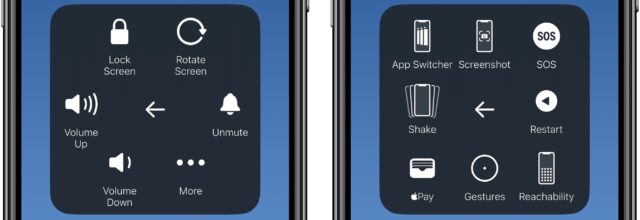
- Custom: The Custom button provides an interface that lets you simulate finger gestures like pinch and rotate, double tap, and long press. Tap a gesture, and a dark dot appears on your screen. Drag it to a place on the screen, and iOS will simulate the gesture at that spot. For instance, if you select Long Press and drop the dot over an app icon, its contextual menu appears. You can create custom gestures in Settings > Accessibility > Touch > AssistiveTouch > Create New Gesture.
Note that the AssistiveTouch button also appears on the Lock screen, although some commands may require you to unlock the device before they execute.
Make the AssistiveTouch Button Disappear, Mostly
The primary drawback of AssistiveTouch is that it slaps a big button on your screen, and wherever you put it, it’s certain to get in the way at some point. Fortunately, you can now make it far less distracting.
Go to Settings > Accessibility > Touch > AssistiveTouch > Idle Opacity, where you can adjust the Idle Opacity slider all the way down to 15% to make the AssistiveTouch button nearly invisible when you’re not using it.
Customize the AssistiveTouch Menu
Useful though the contents of the AssistiveTouch menu are, they may not fit your needs. You can change what’s presented in the menu by default. Go to Settings > Accessibility > Touch > AssistiveTouch > Customize Top Level Menu. Tap any of the icons to see a long list of actions you can use instead of the default action.
For instance, if you don’t need help triggering Siri but have trouble double-pressing the side button to bring up Apple Pay, you could tap Siri, choose Apple Pay from the list, and tap Done. Note that all your shortcuts are listed at the bottom, so you can assign a shortcut to any slot on the menu.
By default, the AssistiveTouch menu shows six icons. You can tap the + and – buttons to add and remove icons, for a total of anywhere from one to eight. Be careful here—if you remove an icon and then add it back, its functionality will be cleared, and you’ll have to reprogram it manually.
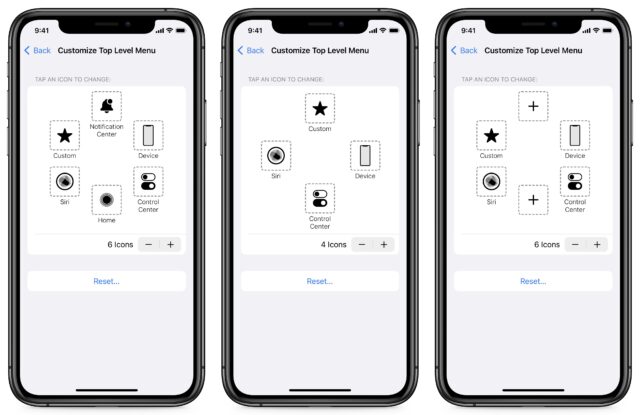
Don’t worry if you mess up. Tap the Reset button below the icon customization interface to restore all the AssistiveTouch defaults. Beware that this button resets both the menu and all AssistiveTouch settings other than any custom gestures you’ve created.
Customize the AssistiveTouch Button
I realize I’ve rather buried the lede here, but now that you know what the AssistiveTouch button does and how you can customize its menu, the real excitement comes when you discover that you can attach custom actions to a single tap, double tap, or long press of the button instead of just using the AssistiveTouch menu.
Open Settings > Accessibility > Touch > AssistiveTouch. Under Custom Actions, there are three settings: Single-Tap, Double-Tap, and Long Press. Tap one and choose an action to change it. The options are the same as when you’re customizing menu options, which means that you can do anything that it provides or that you can create in Shortcuts.
There are tons of interesting possibilities here. I’m experimenting with using a single tap of the AssistiveTouch button to open the Camera app, a double tap to set a HomeKit scene, and a long press to open the AssistiveTouch menu. That way, a single tap lets me quickly open the Camera without fumbling with Control Center, making it easier to capture snapshots of my kids being cute. I can double-tap the button to turn my lights off. And I can still access the plethora of commands available in the AssistiveTouch menu by pressing and holding the button.
So there you have it—a subtle, always-available button to which you can attach three or more actions. What do you plan to do with it?
